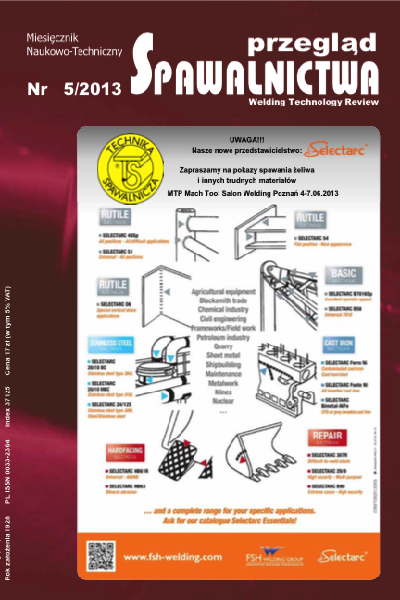Analiza sygnałów emisji akustycznej do wykrywania uszkodzeń zmęczeniowych w stali okrętowej
Main Article Content
Abstract
Uszkodzenia korozyjne i pęknięcia zmęczeniowe to główne przyczyny awarii konstrukcji wszelkich środ- ków transportu, takich jak statki (tankowce), autocysterny i cysterny kolejowe. Oba rodzaje degradacji zarówno ma- teriału, jak i konstrukcji są przedmiotem badań w projek- cie realizowanych w ramach VII kooperacyjnego progra- mu ramowego UE (Transport) pt. Cost effective corrosion and fatigue monitoring for transport products.
W artykule przedstawiono pierwsze wyniki analizy uszkodzeń zmęczeniowych z zastosowaniem emisji akustycznej (AE) przeprowadzone na materiale stosowanym do budowy statków. AE umożliwia monitorowanie propagacji pęknięć w czasie wolnozmiennych prób zmęczeniowych w warunkach asymetrycznego trójpunktowego zginania. Oczekiwano, że warunki propagacji pęknięcia zmęczeniowego będą się zmieniać od sposobu I do sposobu mieszanego I/II, co byłoby bliższe rzeczywistym warunkom pracy. Wykonano również badania zmęczeniowe z wykorzystaniem cieczy w celu określenia i oceny różnicy w propagacji fal AE poprzez ciecz i materiał będący w kontakcie bezpośrednim z tą cieczą. Dane pomiarowe uzyskane podczas badań zmęczeniowych zawarte są w bazie danych, wykorzystywanej do analizy metodą pattern recognition do separacji sygnałów AE pochodzących z propagacji pęknięć zmęczeniowych i korozji od tła akustycznego.
Analysis of acoustic emission signals in detection of fatigue failures in steel for ship hull construction
Abstract
Corrosion damages and fatigue cracks are the main causes of structural failures in all surface transport products as ships, road tankers and railway tank cars. Both types of degradation, i.e. the degradation of mate- rial and structure, are the subject of investigations car- ried out within the framework of a collaborative project of the 7th Framework Programme (Transport) entitled Cost effective corrosion and fatigue monitoring for trans- port products.
In this paper, the first fatigue tests using acoustic emission (AE) performed on ship building materials have been demonstrated. AE enables us to monitor the crack propagation during low fatigue tests performed on specimens under asymmetric three-point bending load. It was expected that fracture behaviour would move from Mode I to Mixed-Modes I/II, which would be closer to reality. For reference, tests were also made in liquid to obtain and evaluate the differences in AE waves propagation in liquid and in material directly contacting this liquid. The data obtained during fatigue tests are included in a database used in pattern recognition analysis to separate the signals due to fatigue crack propagation and corrosion damages from background noise.
Downloads
Article Details
Creative Commons CC BY 4.0 https://creativecommons.org/licenses/by/4.0/
Welding Technology Review (WTR) articles are published open access under a CC BY licence (Creative Commons Attribution 4.0 International licence). The CC BY licence is the most open licence available and considered the industry 'gold standard' for open access; it is also preferred by many funders. This licence allows readers to copy and redistribute the material in any medium or format, and to alter, transform, or build upon the material, including for commercial use, providing the original author is credited.
References
Ohtsu M. and Ono K., J. Acoustic Emission, 3, (1984) 69-80.
NabilBassim M.:Assessment of fatigue damage with Acoustic
Emission, J. Acoustic Emission, 4 (1985) S224-226.
Horrigan P. M., Finn J. F., Tuler F. R., Smith J. H.: Locating Fatigue Cracks by Acoustic Emission Testing, J. Acoustic Emission, 8 (1989) S79-83.
Keinosuke Fukunaga Introduction to Statistical Pattern Recognition, 2nd ed., ISBn 0-12-269851-7.
Baran I., nowak M., Ono K.: Acoustic emission analysis of the overstraining of pipe sinapoly-ethylenereactor, 28th European Conference of Acoustic Emission Testing (EWGAE), Kraków, Poland, Sep.17-19, 2008.
HutchinsonM.Y.,He,J.W.:Asymmetricfour-pointcrackspecimen, J. Applied Mechanics, 67, (2000) 207-209.
